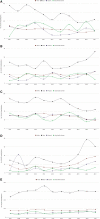Disparities in Cardiovascular Disease Outcomes Among Pregnant and Post-Partum Women
- PMID: 33322915
- PMCID: PMC7955477
- DOI: 10.1161/JAHA.120.017832
Disparities in Cardiovascular Disease Outcomes Among Pregnant and Post-Partum Women
Abstract
Background The incidence of cardiovascular disease among pregnant women is rising in the United States. Data on racial disparities for the major cardiovascular events during pregnancy are limited. Methods and Results Pregnant and post-partum women hospitalized from January 2007 to December 2017 were identified from the Nationwide Inpatient Sample. The outcomes of interest included: in-hospital mortality, myocardial infarction, stroke, pulmonary embolism, and peripartum cardiomyopathy. Multivariate regression analysis was used to assess the independent association between race and in-hospital outcomes. Among 46 700 637 pregnancy-related hospitalizations, 21 663 575 (46.4%) were White, 6 302 089 (13.5%) were Black, and 8 914 065 (19.1%) were Hispanic. The trends of mortality and stroke declined significantly in Black women, but however, were mostly unchanged among White women. The incidence of mortality and cardiovascular morbidity was highest among Black women followed by White women, then Hispanic women. The majority of Blacks (62.3%) were insured by Medicaid while the majority of White patients had private insurance (61.9%). Most of Black women were below-median income (71.2%) while over half of the White patients were above the median income (52.7%). Compared with White women, Black women had the highest mortality with adjusted odds ratio (aOR) of 1.45, 95% CI (1.21-1.73); myocardial infarction with aOR of 1.23, 95% CI (1.06-1.42); stroke with aOR of 1.57, 95% CI (1.41-1.74); pulmonary embolism with aOR of 1.42, 95% CI (1.30-1.56); and peripartum cardiomyopathy with aOR of 1.71, 95 % CI (1.66-1.76). Conclusions Significant racial disparities exist in major cardiovascular events among pregnant and post-partum women. Further efforts are needed to minimize these differences.
Keywords: cardiovascular mortality; disparities in care; health inequities; pregnancy.
Conflict of interest statement
None.
Figures
References
-
- Centers for disease control and prevention . Compressed mortality file 1999–2014 on CDC wonder online data base. http://wonder.cdc.gov/mortsql.html. Accessed March 1, 2020.
-
- CDC . National center for health statistics. 2020. https://www.cdc.gov/nchs/maternal‐mortality/index.htm
-
- Carroll AE. Why is us maternal mortality rising? JAMA. 2017;318:321. - PubMed
MeSH terms
LinkOut - more resources
Full Text Sources
Other Literature Sources
Medical


